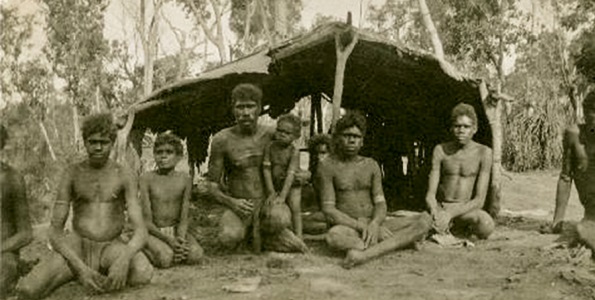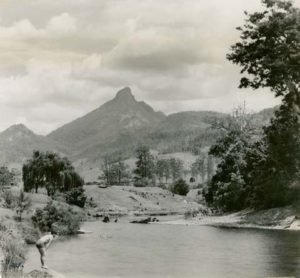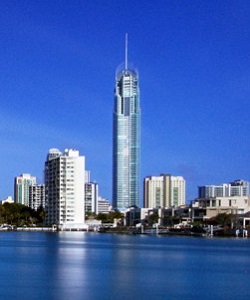A Short History Of The Gold Coast
The story of the Gold Coast, Queensland of course opens in prehistoric times with archaeological research uncovering probable occupation of the region by Australian Aborigines for over 24,000 years before European settlement!
The very first European explorers started to arrive in the latter part of the 18th Century, settlement quickly followed during the 19th century and in 1959 the town was proclaimed a city. These days the Gold Coast is one of the quickest growing regions in Australia.
Kombumerri Aboriginal history in the Gold Coast region
At the beginning of the Eighteenth century there were a number of different Aboriginal clan groups living in between the Tweed and Logan Rivers, namely the Gugingin, Bullongin, Kombumerri, Minjingbal, Birinburra, Wangerriburra, Mununjali and Migunberri peoples who were collectively identified as Kombumerri people and spoke the Yugambeh dialect, for which there is evidence of many specific dialects in the area.
The historic Kombumerri people were hunters, gatherers and fishers and are documented to have trained dingos and even dolphins to help them in their hunting and fishing strategies.

The general vicinity all around present day Bundall, around the Nerang River and Surfers Paradise, together with a variety of similar places in the area have been recognized gathering places for tribes visiting from as far away as Grafton and Maryborough. Huge corroborees (an Australian Aboriginal dance ceremony which may take the form of a sacred ritual or an informal gathering) were definitely held there and remnants of Aboriginal encampments can still be found in the Gold Coast and Tweed River area nowadays.
As Europeans decided to settle the Gold Coast area and commenced agriculture and timber-gathering in the Nineteenth century it is believed by many that the Kombumerri ended up being driven from their customary hunting, gathering and fishing grounds into the hinterland and Aboriginal Missions and reserves which were put into practice on the passing of the Aboriginal Protection and Restriction of the Sale of Opium Act 1897 commonly cited as the 1897 Act
Early European history
English navigator Captain James Cook was the very first documented European to explore the Gold Coast when he sailed past on 16 May 1770.

As an explorer under the commission of the British Royal Navy he named Mount Warning (a volcanic outcrop 25 kilometres inland) as a clearly visible beacon for a dangerous reef off the mouth of the Tweed River close to a rocky outcrop he called ‘Point Danger’.
However the area continued to be uninhabited by Europeans until 1823 when explorer John Oxley came ashore at Mermaid Beach, (given the name after his vessel, a cutter named Mermaid).
In spite of the regions fairly early appearance on colonial maps, it was not until New South Wales surveyors charted the area in 1840 that the region was ultimately brought to the awareness of European settlers.
The hinterland’s source of valuable timber started attracting timber cutters to the area in significant numbers in the mid-ninteenth century and in 1865 the inland township of Nerang (named after the local aboriginal word ‘neerang’, meaning ‘shovel-nosed shark’) had been surveyed and set up as a base for the industry. The adjacent valleys and plains became rapidly developed as livestock, sugar and cotton farms and by 1869 settlement stretched from the mouth of the Nerang River to the Southern edge of Moreton Bay. The township of Southport was surveyed in 1875.
In 1885 Queensland Governor Musgrave constructed a holiday residence referred to as the ‘Summer Place’ on the banks of the Nerang River close to Southport. With it the neighbouring coastal area started to pick up a good reputation as a holiday resort for Brisbane’s affluent and powerful.
The difficult bush tracks and many creek crossings in between Brisbane and Southport made it very hard to get to without a boat, but in 1889 a train line was extended to the town and quite a few guesthouses and hotels were quickly set up.
The population of the area expanded gradually until 1925 when a brand new coast road was constructed between Brisbane and Southport. That very same year, Jim Cavill established the Surfers Paradise hotel 2 kilometres south of Southport and the real tourist boom commenced.
The Gold Coast Tourism Boom
As motor vehicles became a lot more reliable in the 1930s, the number of holiday makers journeying down the coastline road from Brisbane expanded and by 1935 most of the coastal strip in between Southport and the New South Wales border had been developed with housing estates and hotels.
Inflated selling prices for real estate property as well as various other goods and services resulted in the nickname of ‘The Gold Coast’ from 1950 and before long the ‘Gold Coast’ grew to become the popular way to refer to the getaway strip from Southport to Coolangatta.
As the travel and leisure industry expanded, neighborhood business owners started to embrace the expression in their brand names and on 23 October 1958 the ‘South Coast Town Council’ was renamed ‘Gold Coast Town Council’. The region was announced a ‘city’ less than a year later.
By the 1960s the Gold Coast’s infrastructure had developed significantly and the regional construction industry ended up being in a position to support the expansion of high-rise holiday apartment rentals and hotels.
Surfers Paradise had solidly earned itself a reputation as the foremost desired destination and the introduction of bikini-clad meter maids in 1965 to feed parking meters by the beachfront to protect against holiday makers receiving car parking fines was a big hit and a huge publicity success.
The hi-rise explosion carried on in earnest throughout the 1970s and by the time the Gold Coast Airport opened in Coolangatta in 1981, the area had come to be Australia’s most widely recognized family holiday destination and most of the land within 10 kilometres of the coastline had been developed.
 The skyline continued to rise with the opening of the 322.5m (at the time) ‘Worlds Tallest Residential Tower’ Q1, in Surfers Paradise and the development of the modern day theme parks including Dreamworld, Sea World, Warner Bros. Movie World and Wet’n’Wild Water World affirmed the Gold Coast’s popularity as an international tourist centre.
The skyline continued to rise with the opening of the 322.5m (at the time) ‘Worlds Tallest Residential Tower’ Q1, in Surfers Paradise and the development of the modern day theme parks including Dreamworld, Sea World, Warner Bros. Movie World and Wet’n’Wild Water World affirmed the Gold Coast’s popularity as an international tourist centre.
